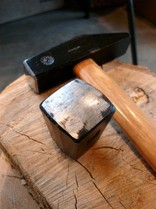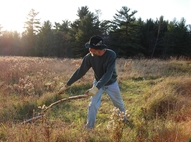"Übung macht den Meister."  Freehand peening is much easier to learn, if you grew up using a hammer of some sort. I remember learning how to use a hammer as a young boy, from my Dad, and also from my neighbor who was a carpenter. It took a lot of practice for a young kid, to develop the hand-eye co-ordination necessary, to smoothly pound a nail straight into the wood, without missing the nail or damaging the wood. Whenever my Dad, or my neighbor was working on a carpentry project, I would be given some scrap wood, some nails, and an old hammer, to keep me busy and out of the way, but also to help me learn how. I was encouraged to practice. Learning how to use a hammer was considered an essential skill. However, that was back in the days before cordless drills, and pneumatic nail-guns. Now, even I seldom use a regular hammer, other than to occasionally hang pictures, or pound in fencing stakes. For most projects, I use screws and a cordless drill, because that way I can take it apart someday, and re-use all the materials. Cordless drills and pneumatic nail-guns have become so common place, that my local farm store recently put most of their nails on clearance. I still know how to use a hammer, however, and I assumed that everybody else does as well. It's such a simple skill.
0 Comments
 I've been meaning to write this all summer. Pictured here at left is a Picard combination scythe hammer, and a very nice little Peddinghaus combination scythe hammer. In my peening manual, I rave about what a great peening hammer the Picard Company makes. Excellent steel and hardness, and I like the camber of the hammer face and cross-peen better than the Peddinghaus. I received my first shipment of Picard hammers in 2007, and I picked out a hammer for myself, and sanded the face and the cross-peen smooth, with 320 and 400 grit wet/dry sandpaper. I've been using the same hammer ever since. |
Botan AndersonArchives
March 2023
Categories
All
|

 RSS Feed
RSS Feed